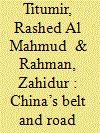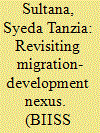|
|
|
Sort Order |
|
|
|
Items / Page
|
|
|
|
|
|
|
| Srl | Item |
| 1 |
ID:
169578


|
|
|
|
|
| Summary/Abstract |
The article provides a unique analytical framework to identify the compulsions and contradictions arising out of China’s Belt and Road Initiative (BRI) and offers feasible sets of solutions amidst burgeoning growth of literature on BRI which is either marred in assertive dogmatization, or excessive apprehensions, or non-feasible utopian (lack of) solutions. The proposed analytical framework, combining necessary and sufficient conditions for deriving gains from new form of cooperation under BRI, suggests integration of production network, transfer of technology and risk-sharing of capital for achieving mutual stability and growth outcomes. The article also deals with alignment of domestic political settlement and normative legitimacy by proposing an equiangular balanced pathway for development for the participating countries with particular emphasis on Bangladesh.
|
|
|
|
|
|
|
|
|
|
|
|
|
|
|
|
| 2 |
ID:
169581


|
|
|
|
|
| Summary/Abstract |
General discussions on formal and informal trade do not reveal the actual scenario concerning informal trade within formal trade though a significant part of Bangladesh’s informal trade takes place through formal channels. This paper attempts to demystify such informal imports through the legitimate channels. Data collected from different entry points for the fiscal years (i.e., FY 2015-16 and 2016-17) have been analyzed using descriptive statistics for providing a fresh perspective in this regard. Findings reveal that importers show less import quantity or value and hide true description of commodities to evade duties and taxes. Some unscrupulous importers show higher and lower volume as lower and higher duty items respectively for dodging taxes. Money laundering in the name of import is also evident. The policy implication to reduce such illegitimate imports into Bangladesh is to put more emphasis on physical examination using non-intrusive scanning or examining tools at the import stage.
|
|
|
|
|
|
|
|
|
|
|
|
|
|
|
|
| 3 |
ID:
169579


|
|
|
|
|
| Summary/Abstract |
The Gulf Cooperation Council (GCC) region is home to about three fourth of Bangladesh’s expatriates. In 2018, labour migration from Bangladesh to the GCC countries fell by about 60 per cent. Although fluctuation is common in overseas employment, this fall in labour migration to the GCC appeared as a concern because it took place at a time when the Gulf countries had started a renewed drive for localization of jobs. In this context, this paper attempts to see the implications of recent drive on localization of jobs by the GCC countries on overseas employment of Bangladesh. The paper argues that although the earlier localization efforts in the GCC region achieved little success and the success of recent localization drive is still uncertain, there is not much room for complacency for labour sending countries either. Growing youth unemployment and uncertain future of oil are mounting pressure on the governments of the GCC countries and hence things might not go as before. It, therefore, seems that although the labour countries like Bangladesh may not worry just now, they should get themselves prepared for change in the GCC labour market in long run, if not in short run.
|
|
|
|
|
|
|
|
|
|
|
|
|
|
|
|
| 4 |
ID:
169580


|
|
|
|
|
| Summary/Abstract |
Migration has been intimately linked with development throughout history. International labour migration has contributed to enrich societies and economies of both countries of origin and destination. The academic discussion on the impact of migration on development has varied from time to time. Consequently, literature on migration-development nexus can be classified into three phases. Chronologically, from 1950 to 1960s, scholars viewed migration as beneficial to development. From 1970 to 1980s, literature considered migration to contribute to poverty and underdevelopment in the country of origin. Since 1990s, migration has been seen as a facilitator to development. In effect, to assess the influence of migration on development, existing literature in these phases tends to focus only on economic indicators, e.g., poverty reduction, national income and GDP growth rate, etc. of development. However, the development paradigm since the 1980s focuses on human indicators, e.g., freedom, choice, opportunity and capability of development. It argues that obsession with economic growth and creation of wealth denies the fact that development is ultimately about people. In this respect, the existing literature on migrationdevelopment nexus not only ignores the human face of development but also pushes people from centre to periphery of development. In this context, the paper comes up with an alternative framework to understand the migration-development nexus. It also argues that by creating opportunities, building capabilities and enlarging choices, international labour migration influences development of the origin country at the micro (household) level. Based on these arguments, to revisit migration-development nexus, the paper takes account of successful international labour migrants’ household in Dhaka city of Bangladesh as a case study.
|
|
|
|
|
|
|
|
|
|
|
|
|
|
|
|
|
|
|
|
|